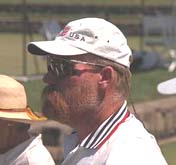
|
Back to |
| The Front Page |
| The Game |
|
Is the game too easy? by Bob Alman Posted April 25, 2002 |
|
|||||||||
Sparked by one-sided scores in the final rounds of top tournaments, the debate on whether and how the game should be made more difficult - that is, interactive - keeps coming up on the email newsgroups and at courtside. In the five-game finals match of a recent British Open, for example, the loser of each game never got a chance to take croquet, and the scores were all 26-0. In the American Rules game the "shut-out" is usually 26-2, with the losing side also never taking croquet. There were many of those scores in the 2001 USCA National Championships at the National Croquet Center in Florida - so many that some prominent figures in the game began to make proposals both serious and whimsical to prevent the "killer leave" - by either changing the lawn or the wicket settings, or adjusting the rules.
Bob Kroeger, co-director of the Nationals and Director of Croquet for the USCA, started the conversation with a specific proposal to allow a player to change the sequence of play in some circumstances. For example, once a side scores one-back, the opposing side could play either ball in the next turn, skipping two balls in the normal blue/red/black/yellow sequence. When four-back is scored the same thing would happen; and if a side scores one-back and four-back in one turn when the partner ball has yet to score one-back at the beginning of the striker's turn, the opposing side could take lift to contact. Kroeger recommends that this rule, however, should NOT apply in the last five minutes of the timed games.

|
| Bob Kroeger, co-director of the Nationals and Director of Croquet for the USCA. |
In addition to preventing the deadly "feed" of the cold (or spent) ball to partner, the opportunity to change the sequence in this situation will also give the outplayer more opportunities to hit in when the blue/black side finishes the turn with balls off the boundary.
Although Kroeger's specific proposal was not widely applauded, a surprising number of top players endorsed the notion that change was needed. They were generally of two kinds: either changing the court layout or equipment; or adjusting the rules of the game. First, let's look at the other options for changing the rules.
The three-hoop limit
Peter Just, leader of the 2002 Grand Prix at the quarter-mark, champions a simple solution: limiting each player to a three-wicket maximum with the striker's ball EXCEPT in the last turn, when all the limitations are lifted. Peels would be okay. This change would inevitably call for the development of more advanced technical skills for America players, who have little need of multiple peels even in top-level tournaments under the current rules. This option would certainly enhance spectator interest. As Just observers, "Spectators would get a chance to see both opponents play at least eight turns per game."
Former national champion Jeff Soo (and 2001 runner-up) declines to champion this solution, however, writing to Peter on the Wyoming board: "I have played (and enjoyed) the 3-point-limit game. It is certainly more likely to be interactive (although I have been on both ends of lopsided scores playing the 3-point limit), but it goes too far for my taste. Peeling opportunities are severely limited when you can score no more than three points on a turn. One of my favorite plays is to "pick up a break out of nothing" when the opponents are joined on the boundary somewhere. This is a real challenge in the current American rules, but usually you need more than three hoops to make it work. There's an element of 'throwing out the baby with the bathwater' in the 3-point-limit game, in that you get rid of some good parts of the game in order to try to make other parts more interesting."
Roqueting out of bounds
This option is advocated in its most extreme form by Johnny Mitchell, Vice-President of the USCA for the Midwest Region. "I know this sounds a lot like Association Laws," Mitchell says, "but there must be a reason that this was allowed [in Association play]. It seems to me to make a lot of sense and should be considered by the Rules Committee. I can't see how it would change the integrity of the American game."

Bob Kroeger roared the first objection to this modest proposal: "Roqueting balls out of bounds and getting two strokes in US Rules would be a profound change!!! Touch sensitivity is a key difference between the two games."
Johnny Osborn commented that the roquet out of bounds would radically change American Rules attack strategies. To which Mitchell replied, "Sometimes change is a good thing."
The lift to contact
Meadowood pro Jerry Stark asked, "Are people concerned about killer leaves after any break is run? If you want more interplay…the best way is by giving the opponent a lift to contact if one-back and four-back are run by the first ball - the same way it is done in the Association game. This would mean in an endgame situation that if the striker gets in and runs one-back and four-back with only one turn for partner, the partner ball would just have to do a triple or maybe get one or two peels in. If you are that far behind at the end of the game, what is wrong with having to do some hard work?"

|
| Jerry Stark - Croquet Pro at Meadowood Resort. |
If this kind of lift to contact were adopted as a rule for advanced play, it's easy to envision the triple-peel becoming a mandatory part of top-level American Rules play, just as it is in International Rules play.
Adjust the tactics, not the rules
Garth Eliassen, editor of the National Croquet Calendar, is a certified croquet prophet. He named the "Chernobyl gambit" way back in the 80's as one of several ways to get control of the game by deliberately declining to go through the first hoop. American Rules play was nowhere near its current level. At the time, many clubs in the east and in Canada actually tried to forbid any kind of tactics that had a player "deliberately" declining to take the first hoop. Players who used the tactics were banned from some invitationals. Today, of course, the Chernobyl and all its relatives are a standard part of top-level play. Here's how Eliassen makes his point:
"All those who are hand-wringing about how to change the American rules to avoid 26-2 shutouts should just change their tactics instead.
"I assume that most of the shutouts at the Nationals were four-balls-in. It is simply foolish, when playing Jeff Soo or Paul Scott or anyone else capable of a shutout, to enter both balls, because you are then giving them the tools to complete their dreaded task in two rounds. The time-proven Chernobyl Gambit and other wilder opening variations can prevent such a shutout; the Chernobyl, in fact, can allow red and yellow, rather than blue or black, to attack first and can make the initial attack easier and more successful.
"Now granted, even with the Chernobyl, there can still be 26-2 shutouts by top players, but they will be far less likely and far more difficult, and the top dogs will have to work harder to achieve them.
"The American game is fine as-is. What is really needed is for players to get over their silly international-play prejudice against holding back opening balls (Aunt Emma! Oh horrors!) and start being more creative and tactical in opening play. That opening flexibility is one of the real beauties of the American game. Changes are not needed."
A 26-2 game is not necessarily a shutout
Both the finalists in the 2001 USCA National Championships went on record to declare that all those 26-2 games were not nearly as cut-and-dried as the advocates for change are declaring. Paul Scott gives all the details of his winning match again Jeff Soo on Croquet World's Events Board (see DAY SEVEN - The Finals). It took 26 turns, at no time until the final rotation was the outcome predestined by a coin toss, the spectators were not bored at all - not even by the boundary dance in the middle - and the second-starting player turned out to be the winner.

|
| Paul Scott (left) the 2001 national champion. 2000 national champion Jeff Soo (right) won every singles game 26-2 - until his loss to Paul Scott in the final by the same score. |
Jeff Soo weighs in with further evidence: "The comments that each of the final three singles games (semi-finals and final) were won "with the toss of the coin" is incorrect. In my semi-final, I broke down on my first break, and Ron Lloyd had the next chance to attack. Unluckily he took off into the peg and his attack failed. So although the score was 26-2, it was not a "typical" one. In both of Paul's games on Sunday, the opponent never took croquet - the classic 26-2. But in the final against Paul, I was the one who won the toss. I chose to offer Paul a difficult attack and first break, and he succeeded. He left me a 100-foot shot at a ball about 18 inches off the boundary. . So while I agree that the game can be too one-sided at top level on easy lawns, let's not get carried away with the scope of this 'problem'.

Soo produced statistics to back up his opinion: "In Championship Flight singles," he point out, "34 players played a total of 147 games. Fifteen of those games, or about 10%, resulted in a score of 26-2. Seven different players were responsible for the 26-2 games. All of these players finished in the top 12, including all of the top 4. Even the most successful players were scoring 26-2 in less than half their wins." (Finalists Scott and Soo each had four 26-2 wins in the event.)
Moreover, "Not all the 26-2 games fit into the classic 'killer' mold -- two clean breaks with a strong leave after the first break. Only one of mine did, I'm sorry to say."
"In general," Soo continues, "I saw a lot of bad leaves (breakdowns or failure to pick up the spent ball - I had breakdowns in two of my 26-2 games), plenty of mediocre leaves (including several of my own), a few very good leaves, and not a single "killer leave", as I define it (when the opponent's only shot is on a boundary ball). "I'm not saying that some sort of advanced rule isn't a good idea, but you shouldn't try to sell it based on a problem that isn't really a problem - yet."
Johnny Osborn said, "While a 26-2 game might be boring for a spectator whose interest in the match may be limited, I do not think I have ever won or lost a 26-2 match that I considered boring. Frustrating? Yes, but that is the nature of the game.
"More importantly," Osborn continues, "I personally do not believe there has ever been a totally perfect game. One player, in some fashion, has to enable the opponent to run off a 26 score like that. It may be shot making...it may be strategy. While one player may play a perfect match, the other did something, sometime, somewhere, that he or she would not likely do, in the same fashion, in the future. We pay and learn from our mistakes."
"Killer" hoops could solve the problem
The "problem" of the killer leave came up in the first place at the 2001 USCA Nationals because the lawns of the National Croquet Center are extraodinarily flat and uniformly textured, and the hoop settings on the sandy court were not maintained at their tightest legal gauge.
Anyone would agree that uniformly tight wickets would create more interactive games by increasing the likelihood that players would break down more often in attempting the all-round break followed by the killer leave. The problem comes in applying this wisdom in real-world conditions. Many experiments with new hoop designs have been tried and continue to be tried - including the controversial Omega Hoop that allows the width to be adjusted while the hoop is in the ground. The jury is still out on that one. Some players have complained that the Omega Hoop is too easy at any setting.

Heavy carrots and broad fins help, undeniably, but the more equipment you have to put into the ground, the more damage the settings cause. During the Golf Croquet World Championships at the National Croquet Center, many spectators commented that it didn't matter for the hard-hitting Egyptians how the hoops were set - they hit the ball so hard, they would simply move the jaws and the entire hoop with sufficient impact to make the ball go through - which of course further loosens the hoop. For America's sandy courts, there is no technical breakthrough in view that would allow uniformly tight hoops in this situation.

Johnny Mitchell has a problem with prescribing tighter hoops as a remedy. "This solution depends on the willingness and ability of tournament directors to comply, and of clubs to provide opportunities to practice with properly set hoops. In any case, we don't have any rules detailing who has the right to get equipment fixed during a game, which might reasonably include the right of players to appeal hoop settings that are wider than permitted by the rules and tournament conditions."
You can't control what kind of hoop setting you're going to have at a given time of day on a given court. "But a rules change," Mitchell argues, "is at least assured of becoming a factor in every game.
The super-court solution
Arthur Bagby, the Alabama visionary who moved heaven and earth to create his own regulation size croquet court on top of a hill next to his home in a Birmingham suburb proposes a solution that comes naturally to a man obsessed with the challenge of converting golfers to croquet. Golf already eats up huge tracts of prime real estate. The development of new golf balls that fly higher, faster and longer than traditional models threatens to make most golf courses in the country "too easy" and obsolete for top-level lay. Golfers are having the same kind of conversation we're having about croquet: Should the new balls be outlawed, or will fairways have to grow longer to accommodate the new balls?
Bagby proposes to change the 21-foot court measure to 25 or 30 feet for advanced play. The 25-foot measure would increase the square footage of a lawn by fifty percent, while the 30-ft measure would approximately double the area. The "supercourt" - 120' x 150' - would be used only in the finals at national events.
The supercourt would kill the "killer leave," in Bagby's opinion. "Anyone who attains a pickup of a four-ball and a super groom will have made a super break," Bagby declares. The National Croquet Center would be the ideal venue to experiment with the supercourt, he says.
"This proposal does not pose any real problem for the rules," Bagby points out, "as smaller courts are routinely employed for American Rules tournaments. The main objection will be from scratch players being handicapped to a 4.0 or 5.0 handicap level."
Why not bring terrain into the equation?
It's odd no one suggested variable terrain as a solution, given that terrain has always provided much of the challenge of golf. While croquet players complain of the slightest variations in the level of a croquet court, golfers think that undulating putting greens create the best conditions for a rigorous test of skill. It's built into the sport. Terrain provides the largest part of the essential challenge in golf and much of the fun. Managing the variability of the terrain is what separates the men from the boys and the players from the spectators.

Terrain is already an element on some famous croquet courts in England where the hoops stand on mounds created by decades of filling in the hoop holes. But there's no reason why there shouldn't be gentle slopes on other parts of the court as well, multiplying the factors that would go into an effective croquet shot - putting two balls exactly where you want them to go, with the uphill braking and the downhill acceleration all taken into account.
One shouldn't go too far, of course. All the boundaries should be level, providing no absolutely safe haven such as are already too numerous on many championship courts in America (by accident, not by design).
Tracing the evolution of the sport over the last century in England and the last 35 years in America, one wonders what might have been lost in the escalating standards of court construction and maintenance that demand near-perfection in levelness and evenness of texture. Palm Beach pro Archie Peck has told me stories of the old court at the Colony Hotel in Palm Beach, with a palm tree and other irregularities taken for granted as a part of the court - and presumably a part of the fun as well.
Playing on the "San Francisco hill court" in the early eighties (an unadapted putting green) was perhaps the most thrilling croquet experience of my life. It could be maddening, but it was equally maddening to my opponent - and it was fun! The particular characteristics of that court - especially hoop #2 on a distinct mound with the terrain sloping down to a treacherous west boundary - were unique and unforgettable.
In 1983, some of us traveled to other, older, and more established croquet venues and lost our innocence. We came back determined to find or build "real" courts, "good" courts, "proper" courts for the San Francisco Croquet Club. Now everyone wants perfect courts.
The standardization of courts begins to equal the homogenization of the entire western culture - the food, the parking lot, the freeway, the fashion, the accents, the croquet courts...they they have to be all the same, no matter where you go. Who says?
The terrain solution is radical and reactionary. It's a return to the distant past of the sport, long before anyone every thought of the "problem" of making the game more difficult. If the terrain is difficult enough, there won't be any shutouts, the outplayer doesn't have time to go to tea, and crowds of spectators might actually watch the play. (That would REALLY be radical.) Articles would be written by croquet pros on how to play each famous court by taking into account the terrain factor.
In the meantime, let's ask the question seriously, once more: Is the American Rules game too easy? I'm a handicap 2, and it's certainly not too easy for me. It's just about right.
The problem with top-level "Association" play
There was time when I would say to people who argue about the relative merits of International [Association] and American Rules, "American Rules are the best for players between handicap 2 and 8, and International Rules are probably better for all the rest - both the top level of players and the bottom level of novices." Now, I'm not so sure. Having looked at this problem, I am inclined to think that both games could do with some tinkering AT THE TOP LEVEL. Given the dramatic example of the British Opens final cited above, I would say that the Association game is more in need of adjustment at the advanced level than the American game - especially when you add Rodger Lane's reports on the 2000 MacRobertson Shield. Lane reported that fully 19 percent of the 300-odd games played were won by a score of 26-0. This is a much larger "shutout" percentage than the percentage of games won 26-2 in major American rules events.
Excellent suggestions for making the "Association" game more challenging and interactive at top level have been fielded. It seems to me that the best of them are very simple, calling for an end-of-turn whenever the striker ball hits the boundary line (except after a roquet). This would make it harder to bring boundary balls into play and establish and sustain breaks; and hoops would have to be run more carefully to ensure that the striker's ball doesn't cross the boundary.

Has anyone given the end-of-turn "Advanced Rule" for Association play a serious trial? I'd like to see a good trial and a report on the results.
By this time the reader will have noticed that all the proposals for adjusting the rules (or laws) to make these games more difficult and interactive at the top level cross the Atlantic - in both directions - and borrow from "the other game": waiving sequence; striker's ball out of bounds; lift to contact at one-back and four back; roqueting out of bounds. Every time a serious proposal is made to change the American Rules game by "borrowing" from the Association game, Americans grumble and shout about preserving the "purity" of the game. Doubtless Association players will do the same from their side of the Atlantic. But the plain fact is that these games have a common lineage, and in their past evolution, you can see all the fundamental elements - like sequence and boundary play - changing over time in response to conditions of play and the technical skills of the top players.
The sport - and the rules and the laws - will necessarily continue to evolve in response to those conditions. Later or sooner, more changes will come.
As an American, I say that the American game at top level, just as it is, still fascinates. Is one player going to keep a ball out of the game at hoop one? How long will they dance on the boundary? Who will make a bold move to seize the initiative, and at what risks? Contributors to this debate have provided proof that a 26-2 score is not necessarily either a "shut-out" or a boring spectacle.
The "killer leave" is not a critical problem today, as Jeff Soo and others point out. It will become a problem only when we have a significant number of players so good at the technical aspects of the game that they make it a problem. That's a great problem for any sport to confront.
In the meantime, the conversation about the problem is interesting and useful. Some good suggestions have been offered for experimental rules. When the time comes, we should be ready to implement one or more of them as an Advanced Rules option for top-level tournament play.